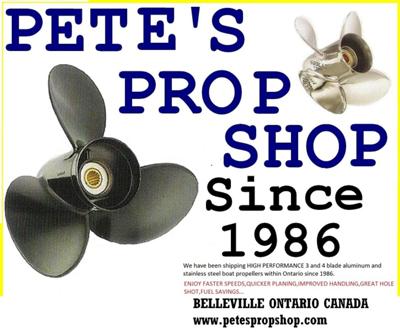Boat Propeller Selection
(Canada)
Recent advantages in outboard technology have made choosing the correct propeller for your boat both easier and more difficult--easier because the number of choices has
doubled, and harder, for the same reason.
Propeller manufacturers have been busy
developing new 3-blade and 4-blade products and size ranges of stainless steel
propellers.The two most important things to remember in choosing a propeller are that it meet your individual needs for your individual application and that it allow the engine(s) to run within the specified RPM range at full throttle. Each boater is trying to meet his requirements, but they can vary a lot.
What’s important to you? Top Speed, Cruising Speed, Hole Shot, Load Carrying, Slow-Speed Handling ?
Two identical boats with identical engines could be propped quite differently, depending on the usage. There is no such thing as the best or ideal prop for all applications. Acceleration may be compromised for top speed and fuel economy, and visa versa.
Three Blades or Four?
Three blade props are the most common. They are available in wide size ranges and cost less than 4-blades. They tend to yield a slightly higher top end speed than 4-blades. They are available in a wider variety of designs and offer more left hand rotation pitch options for twin
counter-rotating engine applications.
Four-blades often provide more stern lift which will help accelerate the hull, especially if it is stern heavy.
They provide faster hole shot pulling skiers and other water sports. When cruising boats, they are often times slightly faster than 3-blades at mid-range rpm’s,resulting in better fuel economy at mid-range rpm.
Often times, a four blade propeller will improve handling and will run
A 4-blade propeller will usually have a smaller diameter for the same pitch size of the 3-blade equivalent. This is one reason they spin up quickly and yield good acceleration. The blades are often a bit smaller but offer more total blade area because of the additional blade, so they have more grip on the water. When switching from a 3-blade prop to a 4-blade,
you’ll usually need to decrease the pitch by 1 or 2 inches to
keep the engine RPM in the same range.
The pitch must be matched to the engine’s recommended rpm range at full throttle. A light boat and load will pull a high pitch prop where as a heavy boat and load would have to run a lower pitch to load the engine less and allow the engine to reach recommended full throttle rpm. Keep in mind that different propeller manufacturers each measure their pitch in slightly different ways with different tolerances. This means that two propellers of the same diameter and pitch from two different companies can yield different performance.
Cavitation is loss of hook-up due to the water literally boiling, caused by extreme low pressure near or at the blade surface or blade edge.
Ventilation is a loss of hook-up due to the introduction of air or exhaust gases around the propeller. Basic blade design and diameter can affect these problems. If the diameter is too small for instance, it can cause cavitation. If the engine is mounted too high, it can cause ventilation. Both of these phenomena can be minimized by installing the correct prop. Going to a larger diameter may help.
Join in and write your own page! It's easy to do. How? Simply click here to return to Boats Forum.

